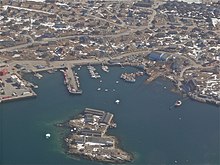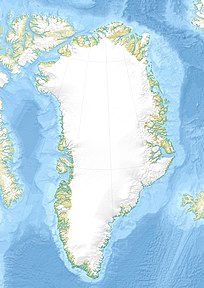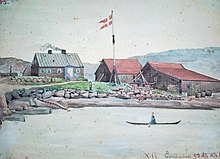Aasiaat
| Aasiaat (spiders) | ||
|---|---|---|
| Egedesminde Ausiait | ||
| Aasiaat aerial photo (2010) | ||
| Commune | Qeqertalik municipality | |
| District | Aasiaat | |
| Geographical location | 68 ° 42 '30 " N , 52 ° 51' 50" W | |
|
|
||
| Residents | 3,069 (January 1, 2020) |
|
| founding | 1759/1763 | |
| Time zone | UTC-3 | |
Aasiaat [ ˈaːsiˌaːtˢʰ ] (according to the old spelling: Ausiait ; Danish Egedesminde [ eːəðəsˈmenə ]) is a Greenland city in the district of Aasiaat in the municipality of Qeqertalik .
location
Aasiaat is on the same island ( Danish Transitøen ) on the south coast of Disko Bay . In the north is the small island of Iperarsuaq ( Danish Tørveøen ), directly to the west is Tupilak . South of the island is the Ikerasassuaq ( Danish Langesund ) channel . The large island of Maniitsoq separates Aasiaat from Disko Bay.
history
Foundation phase
Niels Egede , the second son of Hans Egede , founded a colony in 1759 at Illuerunnerit in the south of what is now the Kangaatsiaq district . In honor of his father, he named the place Egedesminde. Because the place turned out to be extremely unproductive, the colony was relocated in 1763. The area was already 2500 BC. Was settled by Inuit . Poul Egede came to Aasiaat as early as 1738 and found six Inuit families there. The Greenlandic name Aasiaat means "spinning", but is probably derived from the word Aasiat (meeting place). The coat of arms of the former municipality still shows a spider web.
In 1775 Aasiaat had two bacon houses, a cooperage, a brewery and a provisions store, which had been built as peat wall houses, as well as a few sheds. The house, which was a story building, was initially occupied by the colonial administrator, his assistant, seamen and later also the missionary, before a new house was built in 1783. The missionary's room was both a church and a school, so in 1778 an additional school building was built. The old house was then converted into a church and a home for missionaries and catechists.
At first the yields were poor and the trade workers were disorganized. Missionary Berthel Laersen even refused to be transferred to the colony in 1768. Towards the end of the 18th century, conditions improved and the period of whaling began . There was brisk trade with whalers from Germany , Denmark , the Netherlands and other nations. The place was the whaling center of Europe. A oil factory supplied Europe with lamp oil. Around 1800 the place was also an excellent place for seal fishing. In addition, were cod and halibut caught and reindeer and foxes hunted.
Shortly after the colony was founded, the population was already quite high and more and more people moved in. But epidemics occurred several times due to diseases brought in by the whalers. In 1785/86 many people died and in 1793 only 64 people lived in Aasiaat. In 1800 there was another smallpox epidemic , which was survived by only 21 people. In 1805 the population had regenerated to 51, three years later there were 66 people. In 1831 93 people lived in the colony again.
Aasiaat is the place of origin of the Greenlandic families Brandt, Lundblad, Thorin, Geisler and Siegstad.
Development of the colony
In 1828 Aasiaat received a new apartment for the missionary. In 1856 a small church made of half-timbered and stone was built, but it was so small that the church organ had to be shortened at the top to fit into the flat building. In 1863 a house for the colonial administrator and one for a volunteer were built. A new missionary apartment was built in 1893 and renovated in 1907. In 1894 Aasiaat received a house for a captain. In 1901, a 153 m² new church was built, which was built as a timber-clad half-timbered house with a shingle roof. Some components were taken over from the old church. In 1905 Aasiaat was given an apartment for the commercial assistant. In 1906 a hospital was built with an operating room, a room for nurses and students, a kitchen and two hospital rooms with nine beds, which could be extended by six beds. In 1914 a new school with two large classrooms was built. In 1916, the church received a mortuary chapel built from old school materials. In the same year the apartment for the new doctor from Sisimiut was moved here. At that time there was also a shop, a workshop with a cooperage, a forge, a brewery, two storage buildings, a coal house, a oil distillery, a powder house, a petroleum house from 1915 and a bakery that was housed in the missionary apartment from 1828.
Recent history
In 1915 there were 171 Greenlanders and 15 Danes in Aasiaat. Among the Greenlanders were 18 hunters, seven fishermen and a midwife. The Greenlanders lived in 26 houses, which were quite large and well furnished. Most of the people continued to make a living from fishing for seals. Alongside and hunted among other foxes and sea birds, eider ducks , ptarmigan and there were Uuaq and sculpin fishing.
Administratively, Aasiaat, as a colony, was also the capital of the municipality of Egedesminde for a long time, to which the Maniitsoq residential area also belonged. The place was part of the 3rd district electoral council and had a municipal council with three members. In addition, Aasiaat was the seat of a parish, in which a head catechist and a catechist were stationed next to the pastor. From 1916 Aasiaat was the seat of a doctor in its own medical district. The trade in Aasiaat had a colonial administrator and an assistant and usually also a volunteer.
During World War II , Aasiaat played an important role in supplying the Allied troops in Greenland. In 1942 the Americans built a weather station with two barracks as a small base . This was an important economic factor until its closure, after which Aasiaat was dependent on fishing. The economic situation stagnated until the modernization of fish and shrimp processing in the 1980s.
Aasiaat was the capital of the municipality of Aasiaat from 1950 to 2009 . From 2009 to 2018 Aasiaat was in the Qaasuitsup Kommunia and has been the main town of the Qeqertalik municipality since 2018 .
List of colonial employees until 1921
Colonial administrator
The colonial district Egedesminde was administered by the following colonial administrators. From 1879 to 1885, the colonial districts of Egedeminde and Godhavn were administered together.
- 1759–1761: Niels Egede
- 1761–1779: Johannes Pedersen Dorf
- 1779-1782: Niels Fogh Irgens
- 1782–1787: Peder Baade
- 1787–1791: Caspar Gottlieb Lidemark
- 1791–1801: Marcus Nissen Myhlenphort
- 1801–1808: Wilhelm Frimann Koren
- 1808–1814: Jacob Haagen Bast
- 1814–1826: Johan Lorentz Mørch
- 1826–1836: Johan Christian Geisler
- 1836–1839: Peder Goische Kirchheiner
- 1839–1841: Jørgen Nielsen Møller
- 1841–1846: Frederik Waldemark Arntz
- 1846–1865: Nicolai Zimmer
- 1865–1878: Carl August Ferdinand Bolbroe
- 1878–1879: Niels Peter Julius Bentzen
- 1879–1880: Jens Karsten Nielsen Thygesen
- 1880–1882: Valdemar Møller and Otto Alexander Juncker (interim)
- 1882–1883: Niels Alfred Andersen
- 1883–1884: Niels Peter Julius Bentzen
- 1884–1885: Johan Peter Petersen (interim)
- 1885: Johan Carl Joensen (interim)
- 1885–1892: Hjalmar Christian Reinholdt Knuthsen
- 1892–1900: Johan Carl Joensen
- 1900–1903: Louis Victor Mathiesen
- 1903–1907: Oscar Peter Cornelius Kock
- 1907–1908: Carl Frederik Harries
- 1908–1913: Johan Christian Evensen
- 1913–1914: Johannes Otto Frederik Mathiesen
- from 1914: Karl Frederik Hannibal Anton Fencker
Missionaries and pastors
The following people were missionaries or pastors in the colonial district of Egedesminde. From 1792 to 1799 the incumbent in the colonial district of Jakobshavn was responsible for Egedesminde. From 1813 to 1818 there was also no dedicated missionary. Bernhard Hartz co-administered the colonial district from Jakobshavn until 1816. From 1887 to 1893 the missionary in Jakobshavn was also responsible.
- 1769–1777: Hans Hansen Tulle
- 1777-1780: Morten Pedersen Balwig
- 1781-1786: Christian J. Winsløw
- 1786–1787: Jens Koch Lintrup
- 1787–1790: Frederik Christian From
- 1791–1792: Hans Peter Jansen
- 1792–1797: Rudolph Friederich Lassen
- 1797–1799: Hans Peter Jansen
- 1799–1803: Andreas Ostermann
- 1803-1805: Henrik Schou
- 1806–1813: Bernhard Hartz
- 1813–1816: Bernhard Hartz
- 1818-1828: Peder Kragh
- 1828-1833: Thomas Potter
- 1834–1835: Erik Adolf Wandall
- 1835–1843: Jess Lassen Bjerrum
- 1843–1850: Knud Diderik Nøsted
- 1850–1858: Carl Vilhelm Wulff
- 1858-1861: Peder Raae
- 1861–1872: Johannes William Kristoffer Skram
- 1879–1881: Kristian Peter Kristensen
- 1882–1887: Severin Christian Tobias Simeon Mørch
- 1893–1895: Poul Hansen Vibæk
- 1895–1899: Hans Andreas Jakob Theophilus Hansen
- 1899–1901: Christian Wilhelm Schultz-Lorentzen
- 1902–1904: Carl Ferdinand Wagner
- 1904–1906: Hother Berthel Simon Ostermann
- 1906–1907: Erik Jespersen
- 1907-1910: Rasmus Sørensen
- 1911–1913: Rasmus Jørgen Nielsen
- from 1913: Knud Balle
doctors
It was not until 1916 that Aasiaat was appointed the seat of its own medical district. Before that, the doctor Christian Nicolai Rudolph was interim colonial administrator from 1856 to 1858.
- from 1916: Jon Sigurd Øgmundsson Bichel
economy
Aasiaat still lives largely from fishing with trawls and shrimp fishing . There is a shrimp factory. The tourism also plays a major role in Greenland for conditions such a large city. Whale sightseeing tours, kayaking and dog sledding tours are offered. The most important economic sectors are administrative administration and services, followed by retail and transport.
Infrastructure and supply
The port is served by the Diskoline and the Arctic Umiaq Line and thus offers good connections to other cities. In addition, Aasiaat Airport , which opened in 1998 and offers national connections to Ilulissat and Kangerlussuaq Airports via Air Greenland and has a heliport , is located in the east of the city . As usual for cities, Aasiaat is completely paved and therefore car-driven.
TELE Greenland supplies the city with telecommunications and postal services through its own branch. Nukissiorfiit supplies Aasiaat with electricity, water and heat. The water is obtained from freshwater lakes in the area, electricity from diesel generators , and heat for the most part privately from oil stoves or other heating systems. The electricity and heating power plant was built at the port in 1991. Garbage is either burned in a waste incineration plant or dumped in the garbage dump. The city also has a sewage and sewage system to which 82% of the houses are connected. The remaining houses dispose of the sewage directly into the sea.
Development
Aasiaat has shopping facilities in the Spar , Torrak Fashion, JYSK and Pisattat branches managed by Pisiffik . There is also a hotel, a restaurant, a church, a kindergarten, a day care unit, a hospital, an old people's home, a large library, a youth club and a sports hall. Tupilakken 41 plays its home games on the soccer field . In winter you can go skiing in the west of the city , the designated resort also has a ski lift . The village hall of Aasiaat was decorated with paintings by the Danish painter Per Kirkeby .
Aasiaat is an important place of education. There are several schools in the city: The primary school Gammeqarfik , the high school for the north of Greenland GU-Aasiaat ( GUX ), the special school Ado Lyngep Atuarfia and the vocational center Piareersarfik .
Aasiaat has a variety of protected buildings including the Aasiaat Museum , which used to house the colonial administrator.
sons and daughters of the town
- Carl August Ferdinand Bolbroe (1833–1878), Danish-Greenland inspector of Greenland
- Wille Brandt (1865–1921), Provincial Councilor
- Abia Brandt (1886–?), Provincial Councilor
- Hans Lynge (1916–1986), Member of the State
- Lars Ostermann (1916–1982), trade administrator and regional councilor
- Holger Balle (1917–2010), Danish-Greenlandic pastor and provost
- Peter Storch (* 1924), pastor, local politician, teacher and author
- Jørgen Hertling (1928–2017), Greenlandic-Danish lawyer and police chief
- Karl Siegstad (1930–2010), writer
- Knud Sørensen (1934–2009), politician (Atassut) and trade administrator
- Peter Frederik Rosing (1940–2011), journalist, artistic director, writer and translator
- Aqqaluk Lynge (* 1947), politician (Inuit Ataqatigiit), writer and journalist
- Jens Geisler (1951–2010), politician (Inuit Ataqatigiit), teacher and writer
- Anne-Birthe Hove (1951–2012), Greenland-Danish artist
- Naja Marie Aidt (* 1963), Danish writer
- Ole Kristiansen (* 1965), musician
- Michael Rosing (* 1968), politician (Suleqatigiissitsisut) and teacher
- Tue Thomsen (1972-2006), Danish boxer
- Kristian Kristoffersen (* 1988), biathlete
Twin cities
Population development
The population of Aasiaat has been around the same level since 1977. The city is the fourth largest in Greenland.

Web links
Individual evidence
- ↑ Map with all official place names confirmed by Oqaasileriffik , provided by Asiaq
- ↑ a b c d e f g h i j Hother Ostermann : Beskrivelse af Distrikterne i Nordgrønland: Egedesminde District. De grandson Bopladser. Colonies of Egedesminde . In: Georg Carl Amdrup , Louis Bobé , Adolf Severin Jensen , Hans Peder Steensby (eds.): Grønland i tohundredeaaret for Hans Egedes landing (= Meddelelser om Grønland . Volume 60-61 ). tape 1 . C. A. Reitzel Boghandel, Copenhagen 1921, p. 51 ff . ( Digitized in the Internet Archive ).
- ↑ a b c d e Aasiaat at groenlandkreuzfahrt.de
- ↑ a b c d Aasiaat at qaasuitsup-kp.cowi.webhouse.dk
- ^ Aasiaat in Den Store Danske
- ^ A b c Hother Ostermann : Beskrivelse af Distrikterne i Nordgrønland: Egedesminde district. History . In: Georg Carl Amdrup , Louis Bobé , Adolf Severin Jensen , Hans Peder Steensby (eds.): Grønland i tohundredeaaret for Hans Egedes landing (= Meddelelser om Grønland . Volume 60-61 ). tape 1 . C. A. Reitzel Boghandel, Copenhagen 1921, p. 50 f . ( Digitized in the Internet Archive ).
- ↑ Venskabsbyer at qeqertalik.gl
- ↑ Population of Aasiaat 1977–2020 at bank.stat.gl





